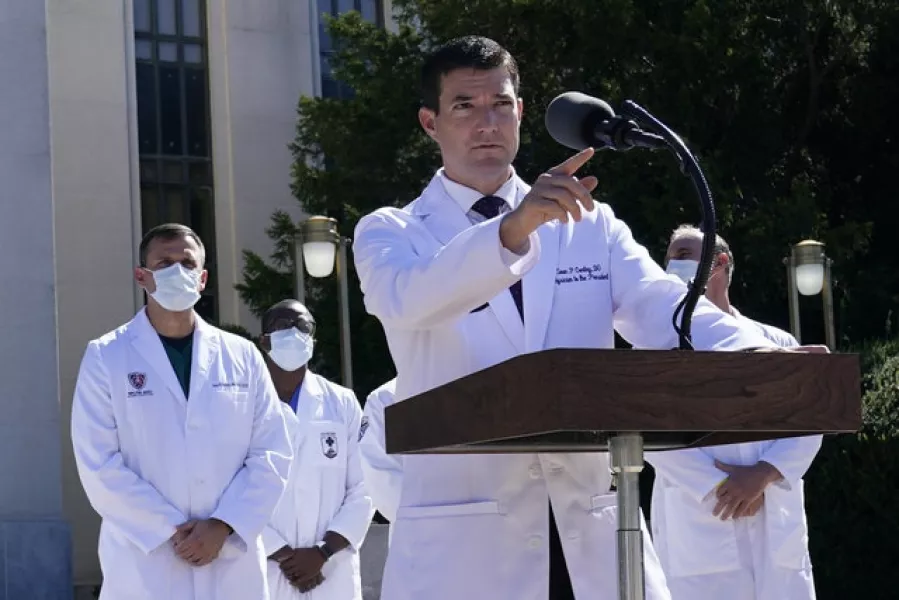The comments came after it was revealed that Mr Trump was administered supplemental oxygen on Friday morning at the White House before he was transported to a military hospital, although staff insisted he had only mild symptoms.
Mr Trump’s doctors, for their part, painted a rosy picture of the president’s health during a press conference at Walter Reed National Military Medical Centre.
But the briefing by navy commander Dr Sean Conley and other doctors raised more questions than it answered.
Dr Conley left murky the issue of whether the president needed supplemental oxygen and declined to discuss exactly when he fell ill.
The president’s doctor also revealed that Mr Trump began exhibiting “clinical indications” of Covid-19 on Thursday afternoon, earlier than previously known.
According to a person familiar with Mr Trump’s condition, the president was administered oxygen at the White House on Friday before he was transported to the military hospital.
Dr Conley, updating the nation on the president’s condition from Walter Reed on Saturday afternoon, said Mr Trump had been fever-free for 24 hours.
While Dr Conley said the president was not currently on oxygen, he refused to say whether the president had ever been on oxygen, despite repeated questioning.
“Thursday no oxygen. None at this moment. And yesterday with the team, while we were all here, he was not on oxygen,” Dr Conley said.
He said that Mr Trump’s symptoms, including a cough and nasal congestion, “are now resolving and improving”.
“He’s in exceptionally good spirits,” said another doctor, Sean Dooley.
The president tweeted not long after the press conference, thanking medical staff.
Mr Trump is 74 years old and clinically obese, putting him at higher risk of serious complications from a virus that has infected more than seven million people nationwide and killed more than 200,000 people in the US.
The administration has consistently been less than transparent about the president’s health as the virus spread inside the White House.
Aides declined to share basic health information about the president, including a full accounting of his symptoms, what tests he has undertaken and the results.
The first word that a close aide to Mr Trump had been infected came from the media, not the White House.
In a memo released late on Friday, Dr Conley did report that Mr Trump had been treated at the hospital with remdesivir, an antiviral medication, after taking another experimental drug at the White House.

He added that Mr Trump is “doing very well” and is “not requiring any supplemental oxygen”.
Dr Conley declined to say when Mr Trump had last been tested before he was confirmed to have Covid-19 late on Thursday.
He initially suggested that Mr Trump was 72 hours into the diagnosis, putting the confirmation of the infection to Wednesday.
Dr Conley later clarified that Mr Trump was administered an accurate test for the virus on Thursday afternoon, after White House aide Hope Hicks was confirmed to be positive and Mr Trump exhibited unspecified “clinical indications” of the virus.
The White House said Mr Trump was expected to stay at the hospital for “a few days” and he would continue to work from the hospital’s presidential suite, which is equipped to allow him to keep up his official duties.
In addition to accessibility to tests and equipment, the decision was made, at least in part, with the understanding that moving him to the hospital later, if he took a turn for the worse, could send a worrying signal.
On Saturday, Dr Conley said Mr Trump’s blood oxygen level was 96%, which is in the normal range.
The two experimental drugs he has received, given through an IV, have shown some promise against Covid-19.
On Friday, he was given a single dose of a drug Regeneron Pharmaceuticals is testing to supply antibodies to help his immune system fight the virus.
On Friday night, he began a five-day course of remdesivir, a Gilead Sciences drug currently used for moderately and severely ill patients.
The drugs work in different ways – the antibodies help the immune system rid the body of virus and remdesivir curbs the virus’s ability to multiply.
“We’re maximising all aspects of his care,” attacking the virus in multiple ways, Dr Conley said.
“I didn’t want to hold anything back if there was any possibility it would add value to his care.”







